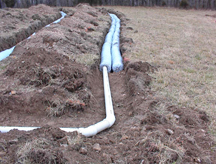
Interested in Drainfield Media?
Get Drainfield Media articles, news and videos right in your inbox! Sign up now.
Drainfield Media + Get AlertsWhen you install or repair an existing septic system, the absorption field size should always be one of the more important design elements. There are many factors involved in sizing an absorption field, including setbacks to wells and property lines, soil and other geological conditions as well as overall site suitability and accessibility.
I’m going to discuss the factors that determine the absorption field size for a conventional septic system. In my state of Missouri, there are minimum statewide regulations sometimes accompanied by additional local regulations.
Keep in mind that regulations in your particular state, county or city may vary from those discussed herein.
Local governing requirements of the process
Sizing an absorption field begins with the regulatory guidelines you are required to adhere to. This may come from state guidelines or a combination of state and county or local guidelines.
The guidelines will state whether the absorption field be assessed by means of a percolation test or by a soil evaluation. Some authorities might require both in some instances.
Perc test factors
One factor in determining the size of the absorption field may require a percolation test. Perc test results are based on how long it takes the soil to absorb a specific amount of water in a sample hole diameter and depth. These tests are normally used only where there is no significant groundwater contamination potential.
There are very specific conditions and requirements involved in this type of soil analysis. Most regulating authorities require only qualified individuals meeting certain regulatory requirements be allowed to perform them.
Soil evaluation factors
A soil evaluation might also be required to calculate the correct size of the field. This type of soil analysis relates directly to soil permeability and is determined by a soil morphology evaluation.
Only qualified individuals may perform these types of tests as set forth by the regulating authority. For instance, in southwest Missouri, registered soil scientists perform most soil evaluations.
Soil loading rate
Both perc tests and soil evaluations provide data used to determine the soil loading rate. The soil loading rate is the number of gallons per day per square foot the soil will absorb.
Once the results of the determined test (percolation, soil evaluation or both) are available, you have the single most important factor in the equation of sizing for an absorption field.
Applying the data for correct absorption field size
The regulating authorities in many areas will base the sizing of absorption fields on a combination of the soil loading rate, the number of bedrooms the system will serve and the number of gallons per bedroom they require to be used in system design.
An example for a conventional system:
- Number of bedrooms: 3
- Soil loading rate: 0.4
- Requirement of gallons used per bedroom: 120
The following formula would be used:
- 3 x 120 = 360 gallons per day
- 360 / 0.4 = 900 square feet of conventional trench bottom
- 900 / 2 = 450 lineal feet of 2-foot-wide conventional trenches using 4-inch perforated PVC and gravel
Alternate options for absorption field size
Remember to consider that there are numerous scenarios available in determining absorption field size. For instance, your local regulatory authority might allow an alternative absorption trench media in lieu of 4-inch pipe and gravel.
 This alternative media might fit into your 24-inch-wide trench and qualify as the equivalent of a 36-inch-wide trench (varies among authorities), which would reduce the required field to only 300 lineal feet of trench.
This alternative media might fit into your 24-inch-wide trench and qualify as the equivalent of a 36-inch-wide trench (varies among authorities), which would reduce the required field to only 300 lineal feet of trench.
Alternately, you could use narrower trenches because of a steep slope and a shallow limiting layer or other factors, in which case, you would need more lineal feet of trench.
Keep in mind that the figures we have discussed thus far are only for the trenches.
Next, you need to determine how close to space the trenches. The regulating authority will require a minimum spacing distance. That minimum spacing plus some allowance for topography variations along with accurate layout allowances of other system components (such as the tank and distribution devices) will help you determine how much total area you need for the absorption field. Don’t forget to leave room for pipes from distribution devices to laterals.
The long-term functionality of any septic system is determined by multiple factors aside from and including absorption field sizing. However, I believe the absorption field to be of utmost importance.
Remember that the soil absorption field is where the majority of treatment occurs. It is also the disposal area. Careful consideration and planning in regards to absorption field sizing is the best place to begin system design.
Jon Hancock owns Envirotek Systems in Kimberling City, Mo. He has been providing septic system services in Missouri for more than 25 years. Visit him at www.enviroteksystems.com.







